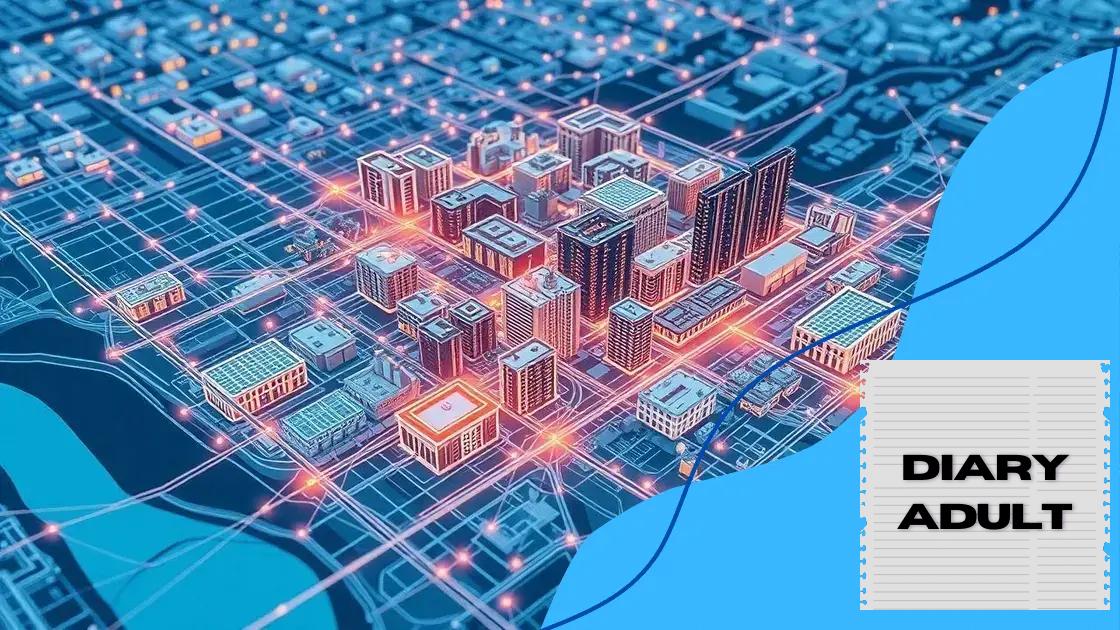The rise of digital twins in urban planning

The rise of digital twins in urban planning enables cities to enhance efficiency, promote sustainability, and improve decision-making through real-time data analysis and advanced simulation techniques.
The rise of digital twins in urban planning is reshaping how cities are developed. Have you ever wondered how technology can simulate real-world urban environments? In this article, we’ll dive into the evolution and impact of this innovative approach.
Understanding digital twins and their applications
Understanding digital twins and their applications is crucial in today’s urban development landscape. Digital twins are virtual replicas of physical entities, used extensively in urban planning to simulate real-world environments.
These advanced models allow city planners to visualize changes, test various scenarios, and predict outcomes. By leveraging real-time data, stakeholders can make informed decisions that affect current and future city layouts.
Key applications of digital twins
Digital twins serve multiple functions in urban planning. They can:
- Enhance operational efficiency by monitoring infrastructure.
- Facilitate predictive maintenance to reduce costs.
- Support environmental assessments by simulating ecological impacts.
- Improve public engagement through interactive models.
Additionally, they can assist in emergency response planning. By simulating various disaster scenarios, cities can prepare better and allocate resources effectively. The transition to digital twin technology not only improves planning processes but also promotes sustainability.
Indeed, many cities worldwide are already reaping the benefits. For example, cities are using these models to evaluate traffic patterns and optimize public transport routes. The seamless integration of data from various sources into a cohesive digital environment allows urban planners to evaluate strategies comprehensively.
Examples of digital twin implementations
Notable cities have embraced this technology:
- Singapore: A comprehensive virtual model of the city helps in urban management and planning.
- Barcelona: Uses digital twins to enhance public spaces and city services.
- Helsinki: Aims to predict energy consumption through its digital urban models.
The real-world applications of digital twins reveal their vast potential. As cities continue to grow, adopting such technology will be essential for smart urban development.
Key benefits of digital twins in urban planning
Key benefits of digital twins in urban planning are becoming increasingly clear as cities adopt this innovative technology. Digital twins offer many advantages, making urban planning more efficient and effective.
One of the primary benefits is the ability to utilize real-time data. By integrating information from various sources, planners can gain insights into how different elements of the city interact. This real-time analysis helps in making quicker and more informed decisions.
Enhanced visualization
Digital twins allow urban planners to visualize complex data. They create a virtual representation of the city that can change dynamically based on updated information. This visualization helps stakeholders better understand potential outcomes of planning decisions.
- Improved collaboration among teams.
- Greater community engagement through interactive models.
- Increased transparency in urban planning processes.
Moreover, digital twins facilitate scenario testing. Planners can simulate various situations, such as traffic flow changes or environmental impacts, before implementing physical changes. This proactive approach can save time and resources by revealing potential issues early.
Furthermore, sustainability is a significant aspect of using digital twins. By analyzing energy consumption and urban heat islands, planners can implement strategies that foster greener cities. The ability to model sustainable practices leads to better resource management.
Cost efficiency and resource optimization
Digital twins can help cities save money by identifying areas where resources are underutilized. By analyzing maintenance schedules and infrastructure performance, municipalities can better allocate their budgets.
- Reduced unexpected repair costs.
- Optimized maintenance activities.
- Long-term financial planning improvements.
In summary, the benefits of digital twins in urban planning are multi-faceted, paving the way for smarter and more responsive cities. As urban challenges grow, leveraging this technology will be crucial for effective city management.
Real-world examples of cities using digital twins

Real-world examples of cities using digital twins highlight the practical benefits and implementations of this cutting-edge technology in urban planning. Various global cities have successfully adopted digital twins to enhance their infrastructure and services.
In Singapore, the government has developed a comprehensive digital twin of the entire city. This model integrates data from various sources, allowing planners to analyze traffic patterns, energy usage, and urban heat effects in real time. The Urban Redevelopment Authority uses this information to improve public transport and optimize land use.
Barcelona’s Smart City Initiatives
Barcelona has also taken significant strides in using digital twins. The city utilizes a 3D digital model for urban planning and management. This digital twin helps visualize the city’s infrastructure, enabling better decision-making regarding public spaces and transportation networks.
- Enhanced street designs based on user feedback.
- Optimized waste management systems.
- Increased safety through simulated emergency responses.
Another impressive example is Helsinki, which uses a digital twin to streamline its urban development processes. The city focuses on environmental sustainability, employing the digital twin to predict energy consumption trends and assess the impact of new constructions. This proactive analysis leads to smarter resource allocation.
In London, the digital twin allows for improved collaboration between different city departments. By visualizing data from transport networks and infrastructure, decision-makers can discuss and coordinate various urban projects more effectively. This data-driven approach leads to better urban landscapes and enhanced public engagement.
Future Outlook and Other Examples
Many cities are looking to adopt or expand their use of digital twins. For instance, Philadelphia is in the early stages of creating a city-wide digital model to tackle issues such as housing and transportation. As awareness of the benefits grows, more cities are likely to follow suit.
- Columbus is focusing on smart mobility solutions.
- San Diego is enhancing its environmental planning with digital models.
- Dubai is exploring data integration into its futuristic planning.
These examples illustrate the versatility and effectiveness of digital twins in real-world urban planning. As cities face increasing challenges, the use of digital twins emerges as a crucial tool for sustainable development and efficient management.
Challenges and limitations in implementing digital twins
Challenges and limitations in implementing digital twins are critical considerations for cities looking to harness this technology. While digital twins offer various advantages, their implementation is not without hurdles.
One major challenge is the availability of data quality and integration. Cities often struggle to gather accurate and comprehensive data from multiple sources. Without high-quality data, the effectiveness of a digital twin can be severely compromised.
Technical and financial barriers
Additionally, there are significant technical challenges. Cities may lack the necessary infrastructure or platforms to support the complex systems needed for digital twins. Establishing these systems can require substantial investment and expertise.
- High initial costs of technology acquisition.
- Ongoing costs for maintenance and updates.
- Need for skilled workforce to manage digital twins.
Moreover, cities must consider data security and privacy concerns. Storing large amounts of sensitive data creates vulnerabilities that can lead to breaches. Ensuring robust cybersecurity measures is imperative, but adds another layer of complexity to implementation.
Another limitation is the potential for stakeholder resistance. Different departments within a city may have differing priorities and may not be willing to share data or collaborate on digital twin projects. This lack of collaboration can hinder the effectiveness of a digital twin and lead to duplication of efforts.
Regulatory and ethical considerations
Regulatory frameworks also pose challenges for implementing digital twins. Cities must navigate various policies around data usage and management, which can slow the adoption process. Additionally, ethical considerations regarding how data is used and who benefits from digital twins need to be addressed to maintain public trust.
- Ensuring transparency in data use.
- Addressing public concerns about surveillance.
- Balancing growth with community interests.
Finally, the evolving nature of technology means that digital twins must be continuously updated. As urban environments rapidly change, ensuring that the digital twin remains accurate and relevant is a persistent challenge.
The future of digital twins in smart cities
The future of digital twins in smart cities is bright and filled with possibilities. As urban areas become more complex, digital twins will play a crucial role in their development and management.
One of the most exciting trends is the increasing integration of artificial intelligence with digital twins. This combination will enhance predictive capabilities, allowing cities to simulate various scenarios. For example, planners will foresee traffic congestion and test solutions before implementing them in the real world.
Enhanced urban planning
With the advancement of IoT technologies, digital twins will rely on real-time data from connected devices. This data will provide crucial insights into urban systems, helping to optimize energy use, transportation, and public services. Cities will use these insights to enhance their infrastructure and design more livable spaces.
- Smart waste management for efficiency.
- Energy-efficient building designs.
- Improvement of public transportation systems.
Moreover, digital twins will foster greater community engagement. Citizens can interact with the virtual models of their cities, providing feedback on proposed developments or policies. This engagement ensures that urban planning reflects the needs and desires of the community.
Advanced sustainability efforts
Sustainability will become a top priority for cities utilizing digital twins. These models can simulate the impact of new policies on the environment and help cities meet their sustainability goals. For instance, by analyzing various energy consumption patterns, cities can identify ways to reduce carbon emissions.
- Assessment of green building impacts.
- Monitoring of urban heat islands.
- Planning of green spaces effectively.
Furthermore, as cities adopt digital twins, the focus will shift toward improving resilience against natural disasters and climate change. By simulating disaster scenarios, cities can better prepare their emergency response plans while ensuring the safety of their citizens.
As technology continues to evolve, the capabilities of digital twins will expand. Future applications will likely encompass more advanced simulation techniques, enabling cities to anticipate and adapt to challenges swiftly. Innovations will undoubtedly lead to even smarter, more responsive urban environments.
In conclusion, the potential of digital twins in urban planning is immense. As cities continue to grow and evolve, the integration of these advanced models will transform how we approach urban development. From enhancing operational efficiency to promoting sustainability, digital twins offer valuable insights that can lead to smarter, more resilient cities. Collaborating with technology will help stakeholders tackle challenges, improve public engagement, and create environments that better serve their communities. The future of urban planning looks promising with digital twins at the forefront of innovation.
FAQ – Frequently Asked Questions about Digital Twins in Urban Planning
What are digital twins?
Digital twins are virtual replicas of physical entities that help simulate and analyze real-world environments in urban planning.
How do digital twins improve city management?
They enhance city management by providing real-time data, allowing for better decision-making and efficient resource allocation.
What benefits do cities gain from using digital twins?
Cities benefit from improved operational efficiency, enhanced sustainability efforts, and greater community engagement.
What are some challenges in implementing digital twins?
Challenges include data quality issues, high costs, technical barriers, and privacy concerns related to data usage.





